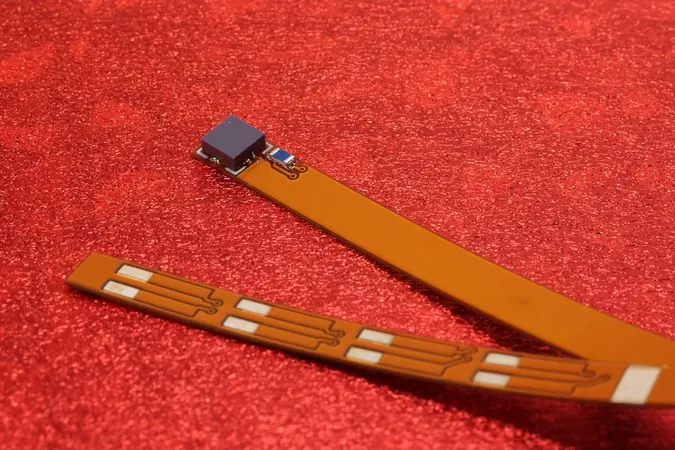
The Future of Semiconductor Electronics: Are We Ready for a Revolution?
2024-11-16
Author: John Tan
The Future of Semiconductor Electronics: Are We Ready for a Revolution?
As the insatiable thirst for faster, smaller, and more efficient electronic devices continues to grow, the existing silicon technology is reaching its physical limits. While Moore's Law, predicting the doubling of transistors on a silicon chip every two years, has guided advancements in chip design for decades, the pace of innovation appears to be slowing. Leading chipmakers, including Intel and TSMC, are now exploring groundbreaking device architectures to maintain momentum, with research institutions like imec in Belgium predicting that new electronic materials could replace silicon in mainstream products by the mid-2030s.
Emergence of Wide-Bandgap Semiconductors
The transition to next-generation electronic materials, however, is expected to be gradual. Among the most promising contenders are wide-bandgap (WBG) semiconductors, like gallium nitride (GaN) and silicon carbide (SiC), both of which outperform silicon in specific applications. These materials feature faster switching speeds and higher efficiency, proving invaluable across the power electronics sector. For instance, silicon carbide is already extensively used in areas requiring high-voltage and high-temperature performance, such as electric vehicle fast chargers and industrial motors.
Gallium nitride, on the other hand, is gaining traction due to its cost-effectiveness when grown on silicon wafers, allowing it to leverage existing manufacturing processes. GaN devices play a critical role in mobile communication infrastructure, data centers, and rapid charging technologies, an area that continues to attract significant investment and market growth. Infineon’s acquisition of GaN Systems in 2023 reflects the anticipation of a booming market, with projections estimating that sales for GaN-based power devices could soar from $250 million in 2023 to a staggering $2.5 billion by 2029.
Diamond: The Ultimate Semiconductor?
While silicon’s reign is challenged by GaN and SiC, the most surprising contender could be diamond. With unparalleled thermal conductivity and an ultra-wide bandgap, diamond semiconductors promise revolutionary benefits, especially as energy systems pivot toward renewables. Despite past manufacturing hurdles, start-ups like Diamfab and Adamas One Corp have made significant strides by producing larger diamond wafers, advancing commercialization feasibility.
2D Materials: A New Era of Electronics
As researchers explore the complexities of 2D materials, graphene has emerged as a revolutionary player. Discovered in 2004, graphene exhibits exceptional electrical and thermal properties but lacks an inherent bandgap for digital applications. Recent breakthroughs have led to the development of semiconducting graphene on a silicon carbide substrate, which could unlock its use in high-speed electronics. Beyond graphene, other 2D materials such as molybdenum disulfide (MoS2) and tungsten disulfide are under investigation, showing potential for enhanced performance in flexible electronics.
Excitingly, carbon nanotubes have gained attention for their tunable electrical properties. Innovations from MIT and recent advancements in AI processors demonstrate the growing versatility and potential of carbon nanotube technology, positioning it as a formidable alternative to silicon as well.
What Lies Ahead?
With a bustling ecosystem of emerging semiconductor materials, the future landscape of electronics may not hinge on a single successor to silicon but rather a variety of materials catering to diverse applications. As we usher in this new era of semiconductor technology, the probability remains that silicon will continue to hold a crucial place in electronics—eventually joining forces with a myriad of innovative materials to meet the demands of tomorrow’s devices.
As we stand on the cusp of what might be a transformative shift, one thing is certain: the quest for better performance in electronics is far from over. The race to uncover the next dominating material in semiconductors has just begun, and technological advancements promise to lead us into a future that is faster, smarter, and more efficient than ever before. Will you be ready for the next revolution in electronics?


 Brasil (PT)
Brasil (PT)
 Canada (EN)
Canada (EN)
 Chile (ES)
Chile (ES)
 España (ES)
España (ES)
 France (FR)
France (FR)
 Hong Kong (EN)
Hong Kong (EN)
 Italia (IT)
Italia (IT)
 日本 (JA)
日本 (JA)
 Magyarország (HU)
Magyarország (HU)
 Norge (NO)
Norge (NO)
 Polska (PL)
Polska (PL)
 Schweiz (DE)
Schweiz (DE)
 Singapore (EN)
Singapore (EN)
 Sverige (SV)
Sverige (SV)
 Suomi (FI)
Suomi (FI)
 Türkiye (TR)
Türkiye (TR)